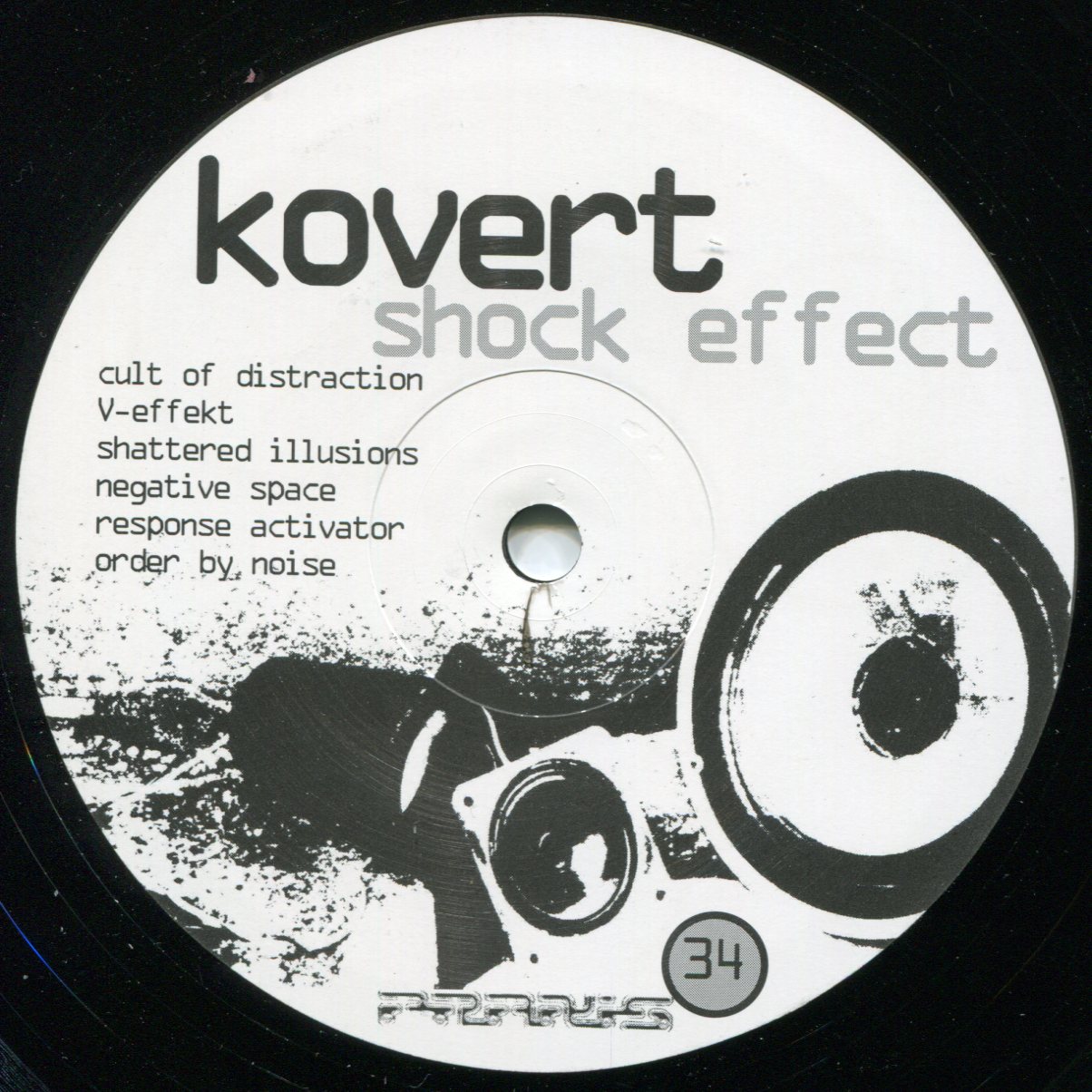Kovert: Shock Effect
Praxis 34
Kovert
Shock Effect
12″ – 2001
1000 copies
This is real breakcore: Six tracks where Brecht meets harsh breaks, low end theory and shredding noise (love songs?).
Conceived as anti-muzak, it asked: could distraction from the banal lead to increased participation in the everyday?


The shock effect
…music represents at once the manifestation of impulse and the locus of its taming…
The shock effect is a series of interruptions. It is constructed for the dance and intended for simultaneous collective experience. These gatherings have the potential to convey precisely and openly to thousands of eyes and ears the disorder of society.
With the current ‘sound of the underground’ shamelessly mirroring the music and star structures of the clubs, the dance often seems a space for collective forgetting and complacency. Just as muzak was originally intended to placate workers already deadened by their conditions and help remove any feelings of resistance that consciousness may foster, much of the current dance scene seems designed to reinforce the illusion that ‘everything is alright’.
Commodified music discourages differentiating consciousness in favour of the disciplining function of music…
Only that which has been emancipated from exchange-value can take on subversive features otherwise commercial control dictates what is aesthetically received…
We attempt to create a negative space where the illusory belief in an existing harmony is shattered; to generate a situation which momentarily absorbs or removes the listener. While attempting to interrupt the listener, sustained interruption is discouraged. An interruption of too stable a duration would only serve to encourage pacification
…the task of the revolutionary soundsystem here is not to make palatable assimilation, but to encourage revolutionary thought and critique…
…to give criticism arms…
Reception in a state of distraction… The experience of music as shock.
Distraction has been adapted to audio noise. When presented with an unknown soundfield devoid of reference points, the usual auditory experience of the listener is interrupted, the listener is driven into a struggle to understand and consequently forced into an increased level of participation. Distraction and concentration form polar opposites. A man/woman who concentrates before a work of art is absorbed by it. in contrast the distracted mass absorbs the work of art. This is most obvious with regard to buildings. Architecture has always represented the prototype of a work of art the reception of which is consummated by a collectivity in a state of distraction. Buildings are appropriated in a twofold manner by use and perception. To truly be a source of distraction there is a need to demonstrate use-value (in the way architecture is appropriated in a distinct state of attention through practical use).
v-effekt…
Brechtian alienation is an aesthetic device to make us aware of a philosophical method, of our sociological and historical condition and situation. The act of alienation or estrangement produces dialectically a bewildered insight into the state of alienation. A momentary befremdung [bewilderment] that is conducive, on the part of the audience, to new insights and in the long run, even action.
We naively believed that we had understood; then all of a sudden we experienced a shock of alienation of profound estrangement. Ultimately by combining and critically comparing these attitudes or experiences, we shall arrive at a renewed, a concrete, a real understanding.
Mans need to expose himself to shock effects is his adjustment to the dangers threatening him. The shock effect should be an ongoing dialectical situation.
The ideas behind it were originally applied to early cinema; the movie theatres of the 20s presented themselves as an incredible opportunity for new perceptual and organisational possibilities. Bertolt Brecht had already developed a practical theory of alienation that he had attempted to implement in his revolutionary ‘epic theatre’. The V-effekt was a fusion of Hegelian, Marxist and Russian formalist ideas. Brecht’s idea was that rather than a straight forward narrative unfolding, a more cut and paste approach should be taken. Brecht wanted to continually prod the audience in an attempt to prevent their passive immersion. He incorporated a number of alienating devices to ‘make what is all too familiar appear strange and what is seemingly self-evident unfamiliar and thus questionable.’
Benjamin updated Brecht’s theory of estrangement and applied it to what he saw as the revolutionary potential of cinema. For Benjamin technology provided the means for a new type of simultaneous collective experience which had the potential to present large numbers of people with the depressing reality of their social alienation, but also more importantly promote active participation in bringing about a change in their conditions. While the capacity for domination is of course still a feature of technology, it is the subversive potential of technology that must be emphasised.
The seductive power of the charm survives only where the forces of denial are strongest: in the dissonance which rejects belief in the existing harmony.
All text written, plagiarised, compiled and edited by August Merz from criticalnoise.net
Review by Low Entropy
“Yeah,noize’n’bass. 6 really sick and fucking distorted tracks, some have beats some don’t. Spin this record and you’ll definitely blast some peoples ears or spine on the dancefloor. My fav track is ‘V-effect’, simply adrenaline rushing.” (review by Low Entropy, quoted in Digitalworldnet catalog 2003).

